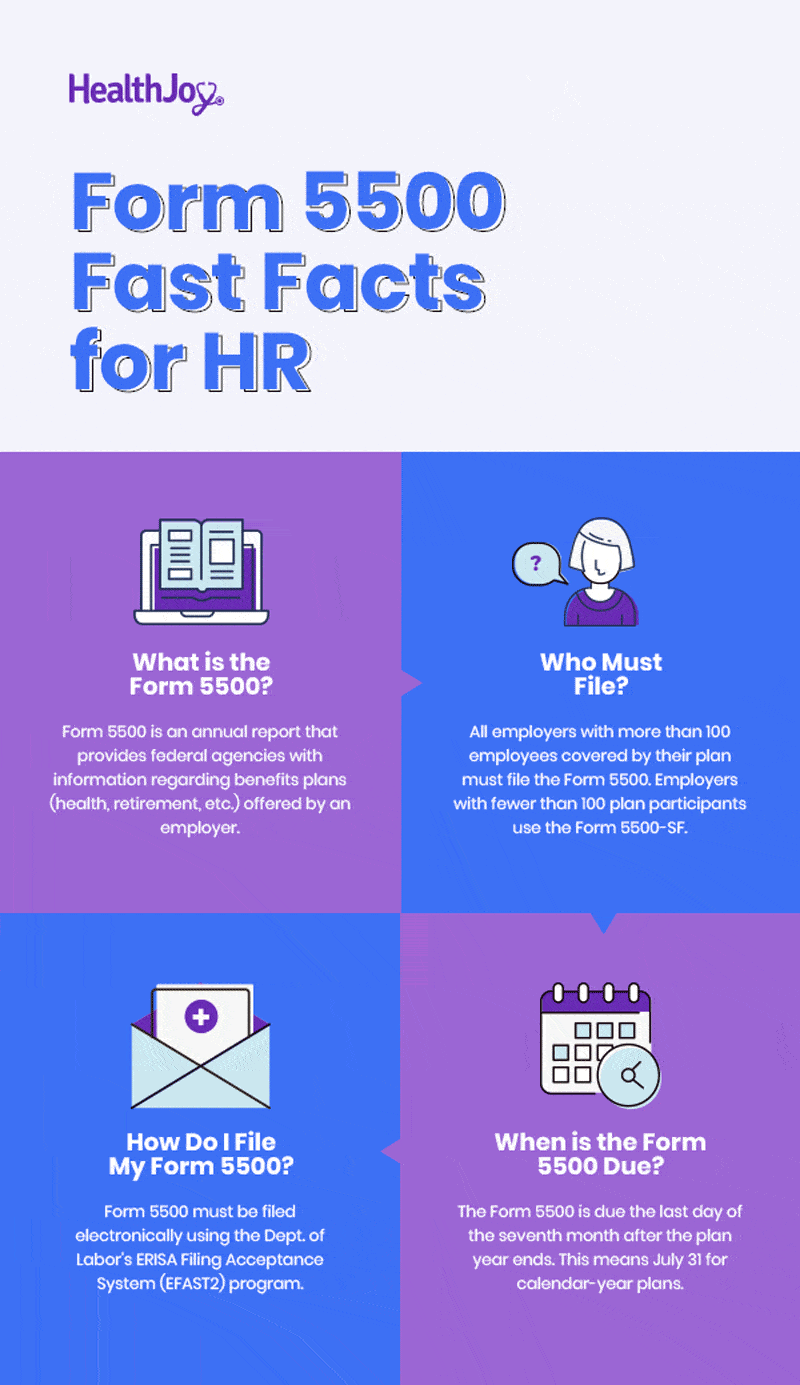How HealthJoy Helps Members Use Health Financial Accounts
Health financial accounts are an excellent tax-free way to save money on eligible medical, dental, and vision expenses. Health Savings Accounts...
Connected Navigation Platform
Guiding to high-value care
Behavioral Health
Foster a mentally healthy workplace
EAP
Supporting holistic wellbeing
Virtual MSK Care
Reimagining musculoskeletal care
Virtual Primary Care
Powered by smart navigation
Surgery Centers of Excellence
Best-in-class surgical outcomes
Virtual Urgent Care
Immediate care, any hour of the day
Chronic Care
A new approach to chronic care
Integrations
Flexible to any strategy

When you hear the phrase “Form 5500,” your eyes probably start to glaze over. We don’t blame you. Anything related to taxes isn’t exactly thrilling to read. However, we’re going to give you all the important facts about the Form 5500 — without putting you to sleep.In this article, we’ll outline exactly what a Form 5500 is, who is responsible for filing it (and when), and share step-by-step instructions for submitting yours.
To understand the Form 5500, you should first be aware of the Employee Retirement Income Security Act of 1974 (known as ERISA for short). It’s a federal law that applies to most private employers. ERISA establishes important standards for retirement, health, and other welfare benefit plans to protect the interests of both the employer and the employee.
To be clear, ERISA doesn’t require companies to provide any benefits plans. It simply regulates those that do. ERISA mandates employer compliance across several categories, including reporting and accountability, disclosures, procedural safeguards, financial protection, and conduct.
Ok, now that we have a better understanding of what ERISA does, where does the Form 5500 come in? The Form 5500 is one form in a series jointly developed by three United States government agencies: the Department of Labor (DOL), the Internal Revenue Service (IRS), and the Pension Benefit Guaranty Corporation (PBGC). This form is an important part of ERISA’s overall reporting and disclosure framework.
More specifically, the Form 5500 is an annual report that provides federal agencies with information regarding benefits plans offered by an employer, its finances, and its operation. The Form 5500 consists of the main form, as well as different schedules and attachments (think of these like an Appendix) businesses submit along with it. To complete all the various schedules and addenda, you should be generally prepared to provide the following information:
The plan administrator is responsible for filing the Form 5500. It depends on the company, but most of the time, this task falls to the HR, finance, or operations department – or a combination of the three. Some organizations also use a Third Party Administrator (TPA) to file the Form 5500. Check-in with your team to see who has historically handled the process.
What about your organization as a whole – does every company need to file the Form 5500? Form 5500 isn’t a one-size-fits-all document, and there are some slight variations depending on your unique organizational profile. The most important distinctions for filing are company size and location:
Essentially, the second and third options are lighter versions of the original Form 5500. So make sure to figure out your status before you start the filling process. If you fail to file a complete return, or if the Form 5500 is rejected for insufficient information, the DOL and IRS may impose penalties or fines.
Also, keep in mind that there are certain entities that are exempt from filing the Form 5500. For instance, daycare centers, certain apprenticeship and training plans, certain employee organization (union) plans, plans for a select group of management or highly compensated employees, and church and governmental plans meeting applicable requirements don’t need to file a Form 5500. If you suspect your organization might fall into one of these categories, double-check to make sure you meet the requirements for exemption.

As we mentioned above, it’s important to figure out which form you need to file first. Remember, the form you use is based on the number of plan participants you have at the beginning of your plan year. So if you covered 150 participants when your plan started in January, but then dropped to 98 by the middle of the year, you’re still accountable for filing the Form 5500 – not the Form 5500-SF.
The DOL requires that all Form 5500 annual returns be filed electronically using its ERISA Filing Acceptance System (EFAST2) program. This is an all-electronic system designed to simplify the submission, receipt, and processing of the Form 5500. The agency no longer accepts paper filings. If you don’t already have DOL sign-in credentials, you can obtain them at www.efast.dol.gov. From there, you’ll have the option to choose between using EFAST2-approved vendor software or the DOL website to prepare and submit your forms.
Form 5500 is two pages long and requests basic information about your benefits plans. This includes the name, the date it first became effective, plan sponsor information, information about the plan administrator, a breakout of the number of participants in the plan at the end of the plan year, how the plan is funded or benefits are provided, any attached schedules, and specific characteristics of the plan. Have this information gathered when you fill out the form, so it’s a seamless process.
The specific schedules that are required to be filed with the Form 5500 will depend on what type of filer the plan is. The DOL outlines the various schedules on its website, which we’ve also laid out below. Check the requirements for your specific form and make sure to fill out the corresponding schedules to avoid any penalties.
Always double check your work. Since mistakes can lead to financial penalties, you want to avoid them where possible. Have multiple contributors — in particular, brokers and accountants, if you have access to these experts — review your numbers and get as many eyes on it as possible. Then, when you feel like everything is ready, submit the form online by the deadline.
Speaking of which…
Thankfully, this question has a straightforward answer: For most plans, the Form 5500 is due the last day of the seventh month after the plan year ends. So let’s say you’re on a calendar-year plan (which many companies are). In this case, the filing deadline would be July 31 — or on the following business day if July 31 happens to fall on a weekend.
This next part is important: if for any reason, you can’t complete your form by July 31, you will need to file an extension using a Form 5558 with the IRS before the due date to avoid late filing penalties – which, trust us, you definitely want to avoid.
It could cost you around $2,140 for every day that passes after the due date. If the Form 5558 is properly submitted before the deadline, an automatic two and a half month extension will be granted. You likely want to avoid the hassle of having to fill out yet another form, so make sure to mark the filing date on your calendar and start early.
While filing taxes are far from anyone’s idea of fun, they’re an important part of ensuring your employees receive the benefits they deserve. And after you finish the tedious work of filing the Form 5500, you shift gears to educating employees about their plans and working to create a successful Open Enrollment period.
Helpful Links
If you’re looking for more information about Form 5500, there are tons of resources out there. Below are some links we recommend exploring:


Health financial accounts are an excellent tax-free way to save money on eligible medical, dental, and vision expenses. Health Savings Accounts...

Since our founding two years ago, our company’s been growing quickly, and we are approaching one hundred employees. At HealthJoy, we work hard...

There are quite a few misconceptions floating around about virtual care. After over a year of challenging changes — where personal and professional...